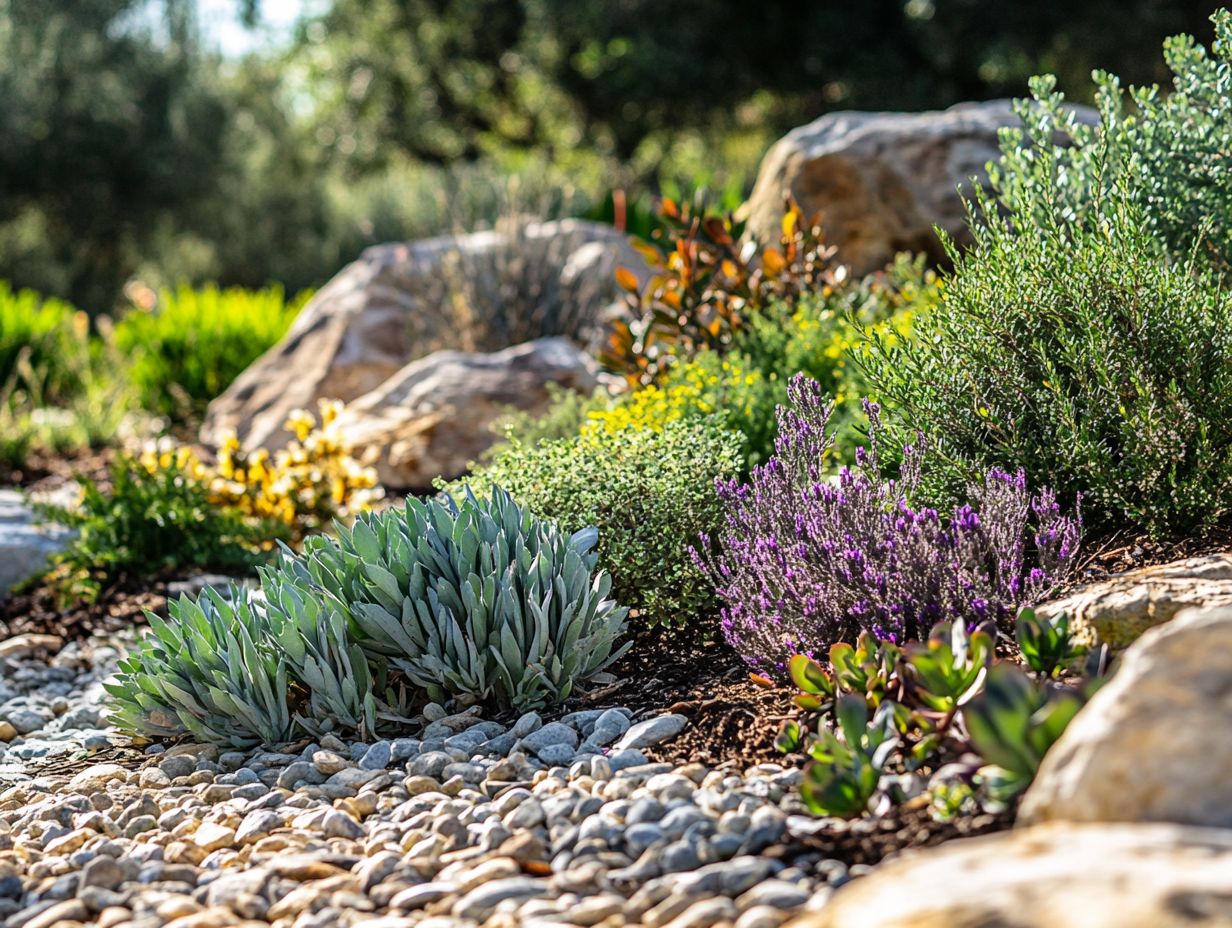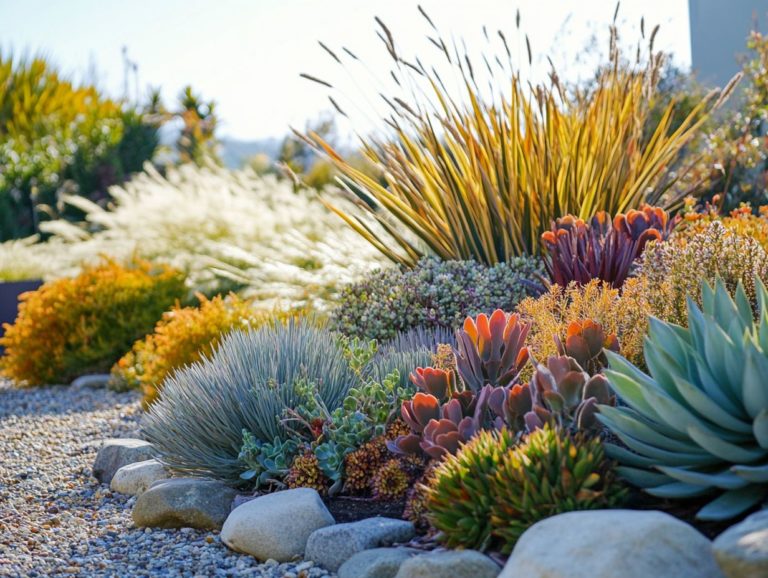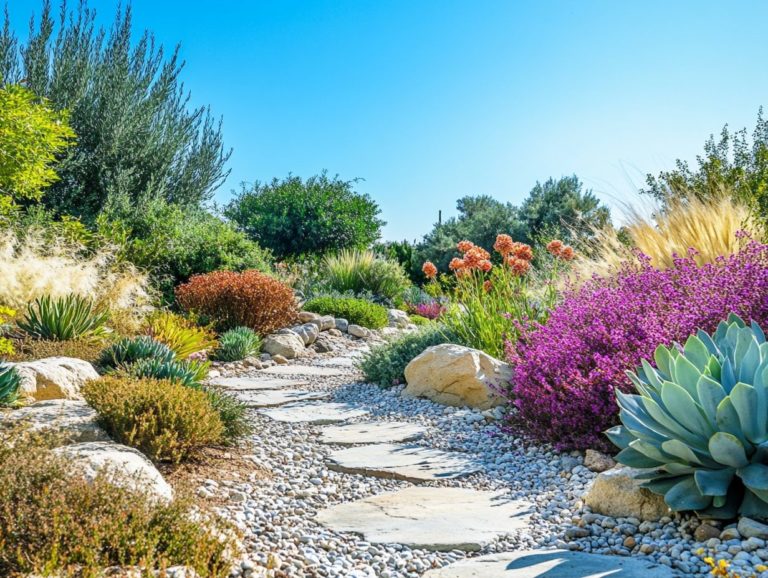Top 7 Drought-Tolerant Ground Covers
In a time when water conservation is paramount, selecting the right plants for your landscape can make a significant impact.
Drought-tolerant ground covers not only enhance the aesthetic appeal of your garden but also reduce water consumption and maintenance needs.
This guide covers seven amazing options like Creeping Thyme, Creeping Phlox, and Hens and Chicks. Discover their benefits, care needs, and how they can enhance your outdoor space sustainably.
Whether you’re revamping your garden or starting anew, this information will empower you to make informed and thoughtful choices.
Contents
- Key Takeaways:
- 1. Creeping Thyme
- 2. Ice Plant
- 3. Moss Rose
- 4. Blue Star Creeper
- 5. Hens and Chicks and Vinca minor
- 6. Red Creeping Thyme
- 7. Woolly Thyme
- What Are Drought-Tolerant Ground Covers?
- Why Are Drought-Tolerant Ground Covers Important?
- What Are the Benefits of Using Drought-Tolerant Ground Covers?
- How Can Drought-Tolerant Ground Covers Be Used in Landscaping?
- What Are the Factors to Consider When Choosing Drought-Tolerant Ground Covers?
- How Can Drought-Tolerant Ground Covers Be Maintained?
- Are There Any Potential Drawbacks to Using Drought-Tolerant Ground Covers?
- What Are Some Other Options for Drought-Tolerant Ground Covers?
- How Can Drought-Tolerant Ground Covers Help Conserve Water?
- What Are Some Common Misconceptions About Drought-Tolerant Ground Covers?
- Frequently Asked Questions
- What are the top 7 drought-tolerant ground covers?
- Why are drought-tolerant ground covers important?
- How do I choose the right drought-tolerant ground cover for my yard?
- Can drought-tolerant ground covers be used in landscaping for both residential and commercial properties?
- How do I care for drought-tolerant ground covers and maintain a low-maintenance landscape?
- Are there any other benefits of using drought-tolerant ground covers?
Key Takeaways:

- Drought-tolerant ground covers are low-maintenance and water-efficient options that can add beauty and functionality to any landscape.
- Choosing the right drought-tolerant ground cover is crucial, requiring consideration of soil type, sun exposure, and plant size.
- By using these plants, you can conserve water and reduce the time and money spent on maintenance and watering.
1. Creeping Thyme
Creeping Thyme shines as a top choice among drought-tolerant ground cover plants, flourishing in sunny spots. This makes it an exceptional addition to eco-friendly gardens designed to conserve water while maintaining an appealing landscape.
This resilient perennial boasts aromatic leaves that release a delightful fragrance when brushed, enhancing the sensory experience of your garden. Typically blooming from late spring to early summer, it adorns your space with delicate purple or pink flowers that attract a variety of pollinators, including bees and butterflies.
With its remarkable ability to spread and fill in bare patches, Creeping Thyme integrates effortlessly into low-maintenance landscapes, requiring minimal care once established. Its lush foliage forms a vibrant carpet effect, transforming your outdoor area into a picturesque and inviting retreat.
2. Ice Plant
The Ice Plant is a resilient, drought-resistant marvel, celebrated for its striking, colorful flowers that infuse any garden with seasonal beauty, especially when nestled in well-draining soil and basking in sunlight.
To truly flourish, this succulent thrives in full sun and requires minimal watering, making it perfectly suited for arid settings. It’s easy to multiply your collection through cuttings or division the way plants grow, making this an excellent choice for gardeners of all skill levels.
Not only does it enhance the landscape with vibrant blooms, but its low-maintenance nature makes it ideal for busy individuals looking to elevate their outdoor spaces without extra burden. Plus, the delightful blossoms attract beneficial insects like bees and butterflies, promoting pollination and nurturing a healthy ecosystem. Consider adding Chamaemelum nobile for its aromatic benefits.
3. Moss Rose
Moss Rose is a stunning low-maintenance plant perfect for your flower beds. It thrives in heat and drought conditions, offering a continuous display of blooming flowers all summer long.
For optimal growth, it flourishes best in well-draining sandy or loamy soils, which help prevent root rot. You won t need to water often; a deep soak once the top inch of soil has dried is ideal to encourage strong roots without the risk of over-saturation.
This vibrant plant produces brilliant, jewel-toned flowers in shades of pink, yellow, and red, creating a truly cheerful landscape. When paired with other drought-tolerant ground cover options like succulents or ornamental grasses, it forms a lively, resilient garden that captivates the eye and conserves water.
Embrace these options to create a beautiful, sustainable garden that conserves water and time!
4. Blue Star Creeper
Blue Star Creeper is a fantastic choice for your garden! It forms dense mats that fill gaps in your flower beds while adding a delightful touch of blue and attracting native pollinators.
This low-growing perennial, which comes back year after year, flourishes in sunny spots and easily spreads across surfaces. It requires minimal maintenance once it s established due to its ability to survive with little water. Its vibrant presence makes it an excellent choice for rock gardens, where it gracefully weaves between stones, providing a beautiful contrast to rugged landscapes.
The creeping nature of this plant pairs beautifully with other drought-resistant companions like sedums or lavender. Together, they create a colorful display that promotes sustainable gardening practices. With its resilience and adaptability, Blue Star Creeper not only enhances your garden’s aesthetics but also supports local ecosystems.
In summary, Blue Star Creeper is a stunning ground cover that thrives in sunny areas and supports pollinators. Transform your garden today with this beautiful plant!
5. Hens and Chicks and Vinca minor
Hens and Chicks are hardy perennials you ll want to embrace if you’re seeking drought-tolerant plants. They thrive in rocky soils and bask in sunny spots, making them a top choice for low-maintenance rock gardens.
These remarkable succulents produce charming rosette formations and delightful offsets, or chicks, which you can easily transplant to enhance your garden s charm. Propagation is simple just divide or use those offsets, and watch them spread rapidly.
Their striking foliage ranges from vibrant greens to rich purples, adding a splash of color and texture that you ll love. They flourish with minimal care and mingle beautifully with other ground covers, allowing you to craft a layered and visually captivating landscape that thrives in arid conditions.
In summary, Hens and Chicks offer striking color and minimal care, making them perfect for any garden. Consider adding them for a vibrant touch!
6. Red Creeping Thyme

Red Creeping Thyme is a remarkable ground cover that wards off deer with its fragrant leaves. It elevates your flower beds with delightful red blooms and a dense, low-growing form.
This hardy perennial flourishes in full sun, requiring at least six hours of direct sunlight each day to enhance its lush growth and vibrant flowers. It thrives in well-drained, sandy or loamy soils, ensuring proper drainage and making it ideal for those dry, sunny spots in your garden.
In the realm of drought-tolerant landscaping, this plant stands out as a resilient option, significantly reducing your need for irrigation once it s established. It also attracts helpful insects like bees and butterflies, contributing to a thriving ecosystem in your outdoor space.
In summary, Red Creeping Thyme is not only beautiful but also beneficial for your garden’s ecosystem. Consider adding this plant for both its charm and its advantages!
7. Woolly Thyme
Woolly Thyme is a standout choice for eco-friendly gardening. It s cherished for its delightful low-growing stature and impressive drought-resistant qualities, creating a vibrant green carpet that thrives in sunny spots.
It flourishes best in well-drained soil, soaking up the sun while remaining resilient even in less-than-ideal conditions. Beyond its beauty, Woolly Thyme plays a vital role in landscape management by keeping weeds at bay and minimizing soil erosion making it an exceptional option for sustainable gardens.
As an edible ground cover, it opens up culinary opportunities, adding a touch of aromatic flavor to your dishes. Its compatibility with other drought-tolerant ground covers invites creative landscaping solutions that champion water conservation.
In summary, Woolly Thyme is a versatile, beautiful ground cover that enhances both aesthetics and functionality in your garden. Explore its benefits for your sustainable gardening efforts!
What Are Drought-Tolerant Ground Covers?
Drought-tolerant ground covers can be your best friend for thriving in low-water conditions. To learn more about these options, check out the best ground covers for drought areas. These carefully selected plants offer a sustainable solution for conserving water while maintaining an attractive landscape with minimal effort.
These resilient plants are essential for reducing water consumption and preventing soil erosion. They form a protective layer over the ground that helps retain moisture, creating an ecosystem that can withstand extended dry spells and support local wildlife.
Consider incorporating common options like creeping thyme, sedum, or buffalo grass into your garden. Not only do they enhance your landscape, but they also improve soil health through better aeration and organic matter retention.
By choosing these ground covers, you embrace a more sustainable gardening approach that minimizes the need for fertilizers and pesticides. It s a win-win for both your garden’s aesthetic and the environment.
Why Are Drought-Tolerant Ground Covers Important?
Drought-tolerant ground covers are vital for your landscaping. They cut down on watering, promote water conservation, and create an easy-to-maintain space that supports local wildlife. Including plants like Lantana camara, a flowering plant that attracts butterflies, can bolster both beauty and utility.
These plants are engineered to flourish in arid conditions, often requiring up to 50% less water than traditional turf. By enhancing soil structure and improving moisture retention, they support the surrounding environment and benefit native ecosystems.
A study published in the Journal of Environmental Management reveals that incorporating drought-resistant landscaping can reduce stormwater runoff by up to 30%. This conservation of precious water resources also aids in filtering pollutants, ultimately enhancing local water quality.
These plants also serve as vital habitats for pollinators and other wildlife, enriching the ecological tapestry of your community.
What Are the Benefits of Using Drought-Tolerant Ground Covers?
Using drought-tolerant ground covers comes with a wealth of benefits. These include reduced water usage, enhanced soil health, and the creation of a sustainable garden that flourishes even in tough climates.
These resilient plants don t just lay down a lush, vibrant carpet across your outdoor spaces; they also play a vital role in minimizing erosion and boosting biodiversity within your garden ecosystem. By forming a dense mat, they effectively suppress weeds, reducing your reliance on chemical interventions.
Their deep root systems improve soil structure, allowing for better water retention during dry spells while ensuring that essential nutrients circulate efficiently.
Incorporating these hardy plants not only elevates the aesthetic appeal of your outdoor areas but also nurtures a thriving habitat for wildlife, all while making garden maintenance a breeze.
How Can Drought-Tolerant Ground Covers Be Used in Landscaping?
Drought-tolerant ground covers offer an elegant solution for your landscaping needs. They allow you to create visually stunning spaces that reduce erosion and improve soil structure while significantly cutting down on supplemental watering.
Imagine weaving a combination of creeping thyme and sedum along your pathways; this vibrant border softens the hardscape and warmly invites visitors. By incorporating these resilient plants among ornamental grasses, you add not just texture but also a captivating atmosphere.
Consider mixed plantings with perennial favorites like lavender or coreopsis, which not only elevate the landscape but also attract pollinators all while keeping water requirements low.
Using stones or decorative gravel as pathways enhances accessibility and adds visual intrigue. This approach promotes efficient drainage and makes your landscaping choices both sustainable and undeniably appealing.
Start transforming your garden today by exploring drought-tolerant options!
What Are the Factors to Consider When Choosing Drought-Tolerant Ground Covers?

When selecting drought-tolerant ground covers, make sure to consider factors like soil moisture levels, sun exposure, and the unique characteristics of the plants. This ensures they harmonize with your landscape.
Understanding the local climate is vital. Temperature fluctuations and seasonal changes can significantly influence plant health and growth.
The type of soil plays a crucial role as well sandy soils drain quickly, while clay retains moisture.
Defining the intended use of your ground cover is essential. Whether you seek aesthetic appeal, erosion control, or habitat creation, matching the right plants to their environment ensures their survival and enhances biodiversity. This fosters a more resilient and thriving ecosystem.
How Can Drought-Tolerant Ground Covers Be Maintained?
Maintaining drought-tolerant ground covers is simple and requires minimal effort. The key is to adopt proper watering practices, apply mulch, and engage in occasional pruning to promote soil health and plant vitality.
One essential step is the application of a mulch layer. This crucial addition helps retain soil moisture, regulate temperature, and suppress weed growth, creating the perfect environment for these resilient plants to flourish.
Keep an eye out for pests periodically, and consider natural pest management strategies. Introducing beneficial insects or using organic repellents can significantly enhance the overall health of your landscape.
By utilizing native plants, you minimize maintenance demands and help create a thriving ecosystem that supports local wildlife. This approach ensures the longevity and beauty of your ground cover, making your outdoor space truly remarkable.
Are There Any Potential Drawbacks to Using Drought-Tolerant Ground Covers?
While drought-tolerant ground covers offer numerous advantages, be aware of potential drawbacks, such as challenges with plant compatibility and the need for specific maintenance practices to ensure their success.
One common issue arises when these ground covers are placed alongside incompatible species. This may stifle growth and diminish aesthetic appeal.
Understanding your local growing conditions like soil type, sunlight exposure, and moisture levels is crucial for selecting the most suitable plants. Regular assessments and adjustments may be necessary to keep the ground covers healthy and effective at conserving water.
By acknowledging these challenges from the start and opting for compatible companions based on their adaptability, you can cultivate a resilient landscape that flourishes even in dry conditions.
What Are Some Other Options for Drought-Tolerant Ground Covers?
Along with popular choices like Creeping Thyme and Ice Plant, you have an array of options for drought-tolerant ground covers. Native plants not only add ornamental value but also support local ecosystems.
Take the resilient Blue Rug Juniper, for example. Its stunning silvery-green hue cascades beautifully over rocks and garden edges, making it an excellent choice for your rock garden.
Consider Sedum, which thrives in poor soil and comes in various colors perfect for creating vibrant patches in your succulent garden.
Don t overlook the fragrant Roman Chamomile; its lovely blooms attract pollinators and can even be brewed into delightful tea.
These diverse ground covers can be strategically placed in your landscapes designed to reduce the need for irrigation, recreational areas, or even eco-friendly herb spirals, enhancing the overall aesthetics of your garden while conserving water.
How Can Drought-Tolerant Ground Covers Help Conserve Water?
Drought-tolerant ground covers are essential for conserving water in your garden. They require far less irrigation than traditional plants, helping to maintain soil moisture levels and enhancing the overall sustainability of your outdoor space.
These resilient plants flourish in harsh conditions and develop extensive root systems that delve deeply into the soil. This allows them to access moisture that shallower-rooted varieties can’t reach. Their low, spreading foliage effectively reduces evaporation and creates a natural mulch that regulates temperature and moisture in the soil.
Consider using varieties like sedum or creeping thyme in your rock gardens or beneath trees, where traditional grass might struggle. By incorporating these ground covers, you can cultivate stunning, low-maintenance landscapes that are both environmentally friendly and visually appealing.
What Are Some Common Misconceptions About Drought-Tolerant Ground Covers?
Many misconceptions surround drought-tolerant ground covers. Some believe they are only suitable for arid climates or that they need little to no maintenance. This leads to misunderstandings about their care and use.
In reality, these plants can thrive in a variety of environments, making them an excellent choice for many regions. They conserve water while bringing vibrant colors and textures to your garden. While some varieties flourish with minimal intervention, others benefit from occasional watering and care, especially when they are settling in and growing strong.
By understanding the specific needs and options available, you can select the right ground covers for your local climate. This ensures a beautiful and sustainable landscape that thrives, regardless of seasonal changes.
Frequently Asked Questions

What are the top 7 drought-tolerant ground covers?
- Creeping Thyme
- Ice Plant
- Blue Fescue
- Sedum
- Wooly Thyme
- Moss Rose
- Purple Ice Plant
Why are drought-tolerant ground covers important?
Discover why drought-tolerant ground covers are a game-changer for your landscape! They withstand periods of drought and require less water, making them a more sustainable and eco-friendly choice for landscaping.
How do I choose the right drought-tolerant ground cover for my yard?
When choosing a drought-tolerant ground cover, consider the growing conditions of your yard, such as sun exposure and soil type. It’s important to select a ground cover native to your region for better adaptation to the climate.
Can drought-tolerant ground covers be used in landscaping for both residential and commercial properties?
Yes! Drought-tolerant ground covers can be used in landscaping for both residential and commercial properties. They are versatile and low-maintenance options that can add beauty and color to any landscape.
How do I care for drought-tolerant ground covers and maintain a low-maintenance landscape?
Drought-tolerant ground covers require little maintenance, but it’s important to water them deeply and infrequently to encourage deep root growth. Adding a layer of mulch helps retain moisture in the soil.
Are there any other benefits of using drought-tolerant ground covers?
In addition to withstanding drought, these ground covers help prevent erosion, suppress weed growth, and attract pollinators to your yard.






